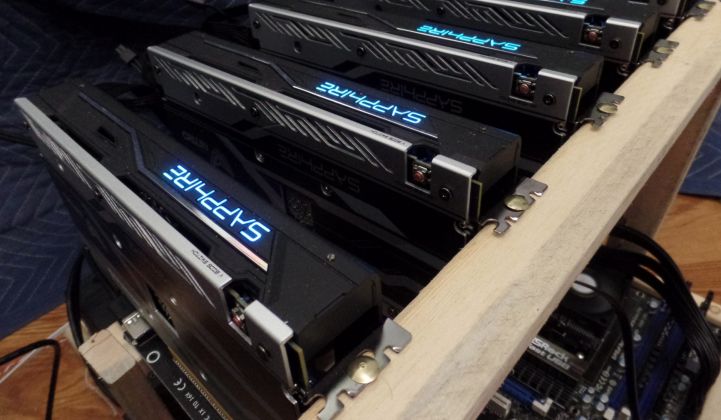It's been a big week for Bitcoin. The price of one bitcoin hit $13,000 on Wednesday, marking a 1,200 percent increase in value this year.
The price of Bitcoin isn't the only thing rising. The energy used to "mine" the cryptocurrency is also skyrocketing -- and people are getting worried.
The Bitcoin Energy Consumption Index tracker puts Bitcoin’s current estimated annual energy use at almost 32 terawatt-hours, roughly equivalent to Serbia’s yearly electricity consumption and ahead of at least 159 other countries, including Ireland and most nations in Africa.
Each Bitcoin transaction is estimated to require the same energy as 4,000 Visa card transactions, said Francois Sonnet, co-founder of the energy generation data project ElectriCChain.
And Power Compare, a U.K. utility pricing comparison site, noted that Bitcoin energy consumption had risen by almost 30 percent in the last month. Based on that rate of growth, Bitcoin electricity consumption will overtake the U.S. by July 2019 and the world by 2020.
The cryptocurrency industry is considering moves to adopt more energy-efficient business models amid concerns that the current method of mining coins could endanger the planet.
“More energy efficient algorithms, like proof-of-stake, have been in development over recent years,” said Chris Conway, managing director of accountancy firm Accounts & Legal Consultants and author of a recent report on Bitcoin energy use.
The energy consumption of proof-of-stake algorithms is “negligible” compared to the proof-of-work methodology employed today by Bitcoin and most other cryptocurrencies, Conway said.
“Bitcoin could potentially switch to such a consensus algorithm, which would significantly improve sustainability,” he claimed. “The only downside is that there are many different versions of proof-of-stake, and none of these have fully proven themselves yet.”
The critical factor in blockchain energy use is how the blocks in each distributed ledger are independently verified without the need for a central authority.
For Bitcoin and most other cryptocurrencies launched so far, authentication is through a proof-of-work protocol which requires a substantial amount of computational power.
As described by environmental researcher Sebastiaan Deetman in Motherboard, “Bitcoin transactions are validated and processed by a decentralized network of volunteers, usually hosting dedicated hardware to perform calculations, called ‘hashes.’”
These calculations are intended to find solutions to a complex mathematical algorithm. The volunteer that solves the problem gets new bitcoins and transaction fees as a reward.
“This network of so-called bitcoin ‘miners’ ensures the security of the system, but unfortunately also consumes a lot of electricity,” said Deetman.
Bitcoin’s algorithm requires that it get more and more difficult over time, as long as mining itself becomes increasingly popular.
“With an approximately 132-year discovery cycle to mine all 21 million bitcoins, mining power demand will go up exponentially,” wrote Tam Hunt in an analysis for GTM on solar-powered mining.
To make matters worse, Bitcoin is just one of a growing number of cryptocurrencies.
Ethereum, the world’s second-largest blockchain network after Bitcoin, today uses one-third the energy of Bitcoin. At around 11 terawatt-hours a year, Ethereum is similar to the electricity consumption in Zambia.
“It's impossible to accurately say what the total consumption of the cryptocurrency mining trend is, but if Bitcoin and Ethereum combined were a country, it'd be the 55th biggest consumer of energy in the world,” said Conway.
“Put over 1,300 more cryptocurrencies on top of that and you can imagine the figures. Adopting Bitcoin as a major currency anytime in the next few decades could have a serious impact on climate change,” he said.
Aware of this impact, Bitcoin, as an organization, advises miners to optimize energy use, said Conway. Bitcoin mining concerns, meanwhile, are increasingly looking for locations with plentiful, cheap energy.
Genesis Mining, for example, has sited the world’s biggest Bitcoin mining facility in Iceland, where it can run off geothermal energy. Bitcoin mining could also run off solar energy, although it is unclear whether any computing firms have explored this avenue.
Sonnet said a new version of Bitcoin Core, the software that runs on Bitcoin’s nodes, could require less computing power to function.
In the long run, though, it seems the only way to overcome mushrooming energy use will be for cryptocurrencies to tweak some of the fundamental features of today’s blockchain networks, particularly as a growing stable of startups seeks to apply blockchains to the energy sector.
Organizations such as SolarCoin, which aims to use the blockchain to help with the transition to carbon-free energy systems, might find it hard to reconcile their missions with the fact that their underlying technology is burning through so much energy.
Thus, for example, “SolarCoin could run through data loggers, daily, on less than 0.07 kilowatt-hours a day,” said Sonnet, making it “thousands of times more efficient than Bitcoin. There are indeed more efficient solutions.”




